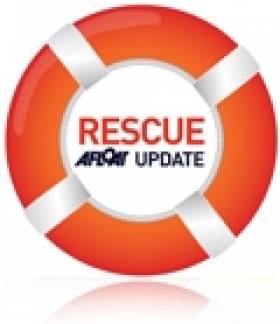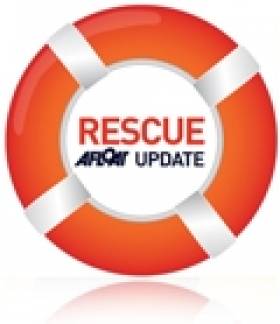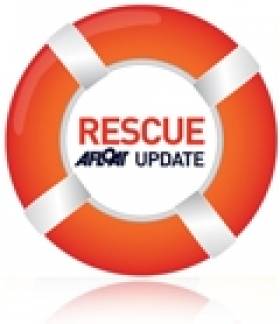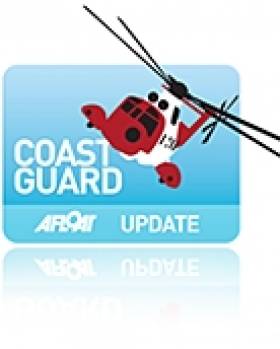Displaying items by tag: Rescue
Irish Residents Among Rescued as Party Boat Hits Rocks in San Francisco
#RESCUE - An unconfirmed number of men from Ireland were among 22 people rescued from a sinking passenger boat in San Francisco Bay in the early hours of this morning.
KGO-TV News reports that the hull of The Neptune was punctured by a rock off Alcatraz around 9.15pm last night local time (5.15am this morning Irish time) and quickly began taking on water.
Matthew Rice was celebrating his bachelor party on the boat with 17 friends at the time - a number of whom has travelled from as far as Ireland - when "all of a sudden it was like boom, just the a big jolt and the next thing we knew the [US] Coast Guard boat came in and got us off," he recalls.
Crew member Rachel Smith, one of four crew on board the party boat, explained how the vessel had veered slightly off course due to a navigation error and hit an area known as 'Little Alcatraz', which resulted in two square-foot holes on either side of the rear hull.
All on board were taken to safety by the coastguard, and attempts were being made to bail the water out of the boat to allow its towing back to San Francisco overnight.
Galway Lifeguard Praised for Canoe Rescue
#RESCUE - A lifeguard at Galway's Leisureland has been praised for his part in the rescue of a canoeist who got into difficulty in the water off Salthill, as The Connacht Sentinel reports.
Ian Brennan raced to the water after a woman looking across from the Galway Bay Hotel spotted the man in trouble a few hundred yards from the shore and raised the alarm.
The Leisureland duty manager, a former competitive swimmer with experience in water safety, said he didn't think twice about the incident.
"I grabbed a ring buoy, ran across the road, stripped down to my boxers and swam to the person," he said.
Brennan managed to swim ashore with the canoeist as Galway's RNLI lifeboat was being dispatched to the scene.
He also commended the lifeboat crew "for the speed at which they launched" and for their quick treatment of the canoeist for hypothermia.
Despite the applause he received from onlookers once back on land, Brennan described his actions as "no big deal".
The Connacht Sentinel has more on the story HERE.
Busy Week For Howth Coast Guard With Two Separate Cliff Rescues
#COASTGUARD - Last week saw two rapid responses by volunteers with the Howth Coast Guard in separate incidents on the peninsula.
On Saturday 22 September a walker on the Howth Head cliff path who suffered an ankle injury was evacuated for treatment.
The walker was with a friend on the path near Red Rock when the accident occurred, rendering her unable to walk. The friend called emergency services who dispatched the on-duty crew at the local coastguard station.
The team arrived quickly on scene and prepared the casualty for evacuation across farmland to the nearest location accessible by road, where they were met by paramedics.
Howth Coast Guard said that as the coastguard service's 999 centre was contacted quickly, a speedy evacuation was carried out before temperatures dropped significantly.
Later in the week, on Thursday 27 September, the Howth Coast Guard joined the Howth RNLI lifeboat and the Irish Coast Guard's Rescue 116 helicopter in responding to a Garda request for assistance with a faller on the cliffs of Howth.
The casualty was reportedly airlifted to Tallaght Hospital by helicopter. There is no word yet as to the faller's condition.
More On Power Boat Fireball Off West Cork
#BOAT FIRE - The Irish Independent has more on the incident in which a motor cruiser caught fire off West Cork at the weekend, as previously reported on Afloat.ie.
Denis Ryan, a car dealer from Inishannon in Co Cork, says he is lucky to be alive after a sudden fire engulfed his power boat off the Seven Heads Peninsula on Saturday afternoon.
Ryan was piloting his boat alone in the waters near Courtmacsherry when the incident occurred, destroying the plastic-hulled vessel in a matter of minutes.
His immediate distress signal was picked up by the Naval Service vessel LE Niamh which was in the area at the time, and Ryan himself was quickly rescued from the water by a passing yachtsman.
Diver Dies After Saltee Islands Incident
#RESCUE - RTÉ News reports that a man has died following a diving accident off the Saltee Islands at the weekend.
The 25-year-old is believed to have rapidly ascended from 25 metres below the surface while on a dive with three others on the morning of Saturday 22 September.
Irish Coast Guard operatives from Waterford and Kilmore Quay were involved in the operation to rescue the man, who was later pronounced dead at Waterford Regional Hospital.
Meanwhile, RTÉ News also reports on the rescue of a man from a burning motor cruiser off the Seven Heads Peninsula in West Cork on Saturday afternoon.
Crew aboard the Naval Service vessel LE Niamh, on patrol in the area, transferred the man from his vessel to Kinsale. The boat later sank after attempts to extinguish the fire.
Fisherman Airlifted to Galway Hospital
#RESCUE - The Irish Examiner reports that a man has been airlifted to hospital after taking ill on a fishing vessel off Galway yesterday Friday 21 September.
The man reportedly experienced chest pains on board the fishing boat off the coast of Spiddal.
Galway RNLI's lifeboat was dispatched to the scene to attend to the man before he was airlifted by Irish Coast Guard rescue helicopter to Galway University Hospital. His condition is as yet unknown.
Irish Diver Rescued from Rough Seas in Malta
#RESCUE - An Irish woman was rescued from rough Mediterranean seas while diving in Malta last week.
According to Gozo News, the 44-year-old got into difficulty on Tuesday evening while on a dive off Qbajjar on the Maltese island of Gozo.
Passers-by on shore notified local police who contacted the Armed Forces of Malta operations centre. Both a rescue helicopter and patrol boat were quickly dispatched to the location.
The woman was located by the helicopter and winched to safety with no reported injuries.
Down Coastguard Officers Commended for Rescues
#COASTGUARD - The Newry Times reports on the award of the Chief Coastguard's Commendation to two Co Down coastguard officers for separate rescues last year.
Keith Campbell and John Kirkpatrick of the South Down Coastguard Team were recognised by the Maritime and Coastguard Agency at an awards ceremony in Newcastle Coastguard Station last Wednesday in what was also a first for Northern Ireland.
Alliance Party Councillor Patrick Clarke congratulated the officers for showing "exemplary bravery in carrying out their duties last year saving the lives of adults and children at separate incidents at Dundrum Inner Bay."
Chief Coastguard Peter Diamond from headquarters in Southampton made the presentation at the event attended by senior coastguard officers and officials from other emergency services.
An amazing sea rescue, NAB-ing change, UK politicians support what Ireland’s will not, sailing in Galway and Mayo and much more in your TIN this week…
An amazing sea rescue, NAB-ing change, UK politicians support what Ireland's will not, sailing in Galway and Mayo and much more in your TIN this week.....
AMAZING SEA RESCUE
A 31-year-old seafarer has survived ten hours of swimming after ships in the Atlantic Ocean 525 miles offshore shouting to be rescued. It has been described as one of the most amazing sea survival and rescue stores. He fell off his ship after feeling faint when he leaned against a railing but blacked out, collapsed and fell overboard. The crew of the Maersk Bintan did not miss him for 2 hours after he had fallen off at 0715 hours. At that stage Tanawoot Pratoom, who came back to consciousness when he hit the water, had been swimming after ships he saw and shouting for help. The ships' crew had called a distress alert. Five vessels as well as a search-and-rescue plane were involved and the US Coast Guard was using drift simulation technology to locate his position. His own vessel doubled back on its course. He was spotted by another vessel involved in the search, the bulk carrier, Stalo. After ten hours he was pulled from the water by crewmates of his own ship. He said he had followed safety procedures by removing his boots and overalls in the water and had spent the ten hours swimming towards passing ships until he was sighted. His ship was en route from Panama to Algeciras where the seafarer was repatriated to his home in Thailand. He is married and has two children, an 8-year-old daughter and a three-month old son.
REFITTING THE NAB

The NAB Tower
The NAB Tower is a vital aid to navigation in the Solent but the structure has been deteriorating and is being restored by Trinity House, the UK lighthouse authority. It was originally built as a British defensive structure for the Admiralty in 1918 and has been used as a lighthouse since 1920 replacing the previous NAB Lightvessel. It was staffed by Lightkeepers until automation in 1983. At present the helicopter pad atop the lighthouse cannot be used and boat access has been difficult due to the deteriorating condition of the external superstructure. Trinity House is to extend the lifespan of the NAB Tower by up to 50 years. The height will be reduced and all external steel and cladding will be replaced by concrete. Work is scheduled to be completed in the summer of next year. It will be suspended during the winter due to difficult seasonal conditions.
YOLING IN GALWAY
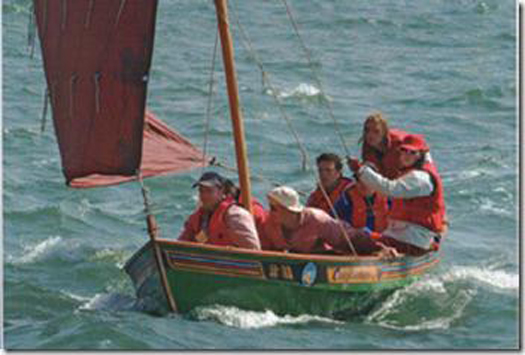
The Ness Yoal
The little beauty pictured here visited Galway Bay Sailing Club from France, but originated in Norway, were exported to the Shetlands and are now active in France, demonstrating the great linkage internationally through traditional sailing boats. The 'Yoling Club Peillac' is based in the village of Peillac, in South-East Brittany. It was created to promote traditional sailing amongst youth and especially the practice of navigation on the Ness Yoals, following the construction of three of these boats in 2000. The club aims to connect with other associations sharing similar interests in 'sail and oar' boats and to encourage the construction of traditional yachts and organises events to promote cultural heritage related to traditional sailing.
Ness yoals are wooden open boats of 6.90 m in length, rigged with a sail to the third of mahogany colour. The crew is composed of 7 people (six rowers and a coxswain). The Ness Yoals originated in Norway hundreds of years ago and were exported to the Shetland islands in Scotland, where it has a special place in the history of inshore fishing. It was considered a very seaworthy vessel and the seamanship of the men who crewed them, made the
difference between survival and starvation for many families there. Despite the development of commercial fishing, which favoured larger-decked boats, the Yoal has survived into the 21st century, due to the interest in Yoal-rowing as a sport and the craftsmanship of boat-builders like Tommy Isbister and Ian Best who still produce these craft.
UK POLITICIANS BACK SAIL TRAINING
Renowned naval architect Colin Mudie has designed a proposed new UK sail training flagship. Riding on the tide of successfully staging the Olympics and the Diamond Jubilee celebration a charitable trust has been set up called – UK Flagship – to promote the concept of a 650-foot tall ship which would be the largest and most advanced square-rigged vessel in the world. It is envisaged as a sail training ship with the additional role of being a 'floating ambassador' for the UK promoting trade and scientific research, with facilities aboard including conference rooms, oceanography and marine biological study resources and could carry up to 200 trainees. The cost is put at stg£80m., to be raised without State support. Launch of the ship is targeted for 2016 and stg£15m. has already been raised according to the backers, of which the Principal Trustee is Royal Navy Rear Admiral David Bawtree. UK sailing journalist Libby Purves is also involved in the project. The Daily Mail
Newspaper has launched a fundraising campaign for the vessel.
While not allocating any funding, leading UK politicians have pledged support and backed the project, showing at least an interest in sail training which their Irish counterparts lack. Deputy UK Prime Minister Nick Clegg said the project provided "a brilliant opportunity to promote the marine world and life at sea" while the UK Labour Party Leader, Ed Milliband, said it was a cause which deserved support because of its aim of "giving opportunity to youth."
The tall ship will feature four masts acting also as solar panels. Colin Mudie designed the sail training ships Royalist and Lord Nelson.
Operating tall ships is difficult in current economic times although the South African Government approved the conversion of a former research vessel by the country's Maritime Safety Authority to carry 50 cadets for sea training. The country has less than 2,400 seafarers and the government has adopted a policy to increase annual officer cadet intake for training which at present is 120 per year.
MAYO SAILING CLUB
When in Mulrany, Co.Mayo, this summer I enjoyed the idyllic view of Clew Bay and the 365 islands, one for each day of the year as local people proudly claim. Mayo Sailing Club was founded in 1982 and has this area as its immediate sailing grounds.
This is a thriving vibrant club, based at Westport, with a diverse range of sailing activities throughout the season - cruiser racing on Thursday nights, junior and senior dinghy racing on Tuesdays and cruising voyages.
Thirty-six trainee sailors from the club had an overnight sailing trip from Rosmoney Pier to Inishoo Island in Clew bay. It concluded the Adventure Module of the ISA Small Boat Sailing Scheme and also marked the end of the Junior Sailing course. The return voyage involved the trainees sailing a challenging beat home on a route through around many of the islands before arriving at Mayo Sailing Club.
FISHING LEADER HONOURED
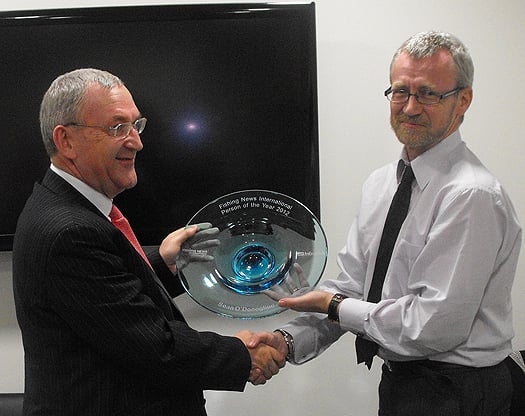
In London this week Sean O'Donoghue CEO of the Killybegs Fishermen's Organisation was presented with the Fishing News International magazine's Person of the Year award. The presentation was made by IntraFish Fishing Publications Editor Cormac Burke who is originally from Killybegs.
#COASTGUARD - Campaigners opposed to the closure of the Clyde coastguard station in western Scotland will next Friday hold a red flare protest against the UK government's plans.
STV News reports that a flotilla of boats will gather at the Greenock Navy Buildings on the evening of 31 August to release red flares in "a show of thanks for the coastguard for their hard work and dedication", acccording to Save Clyde Coastguard campaign founder John Houston.
He added: "We realise that the centre is going to close. That is a given. It would take a miracle now to have that rescinded by the government."
As previously reported on Afloat.ie, staff at the Clyde station had their hopes of a reprieve dashed after a U-turn on assurances from British Prime Minister David Cameron.
The scrapping of the control centre at Greenock will see the loss of 31 jobs, with future River Clyde rescues being handled from stations around Scotland until 2015, when responsibilty will transfer across the North Channel to the Bangor control centre in Northern Ireland.
Campaigners and staff alike have shown concerns over the loss of local knowledge that could be vital to saving lives in difficult search and rescue operations.
STV News has much more on the story HERE.






























